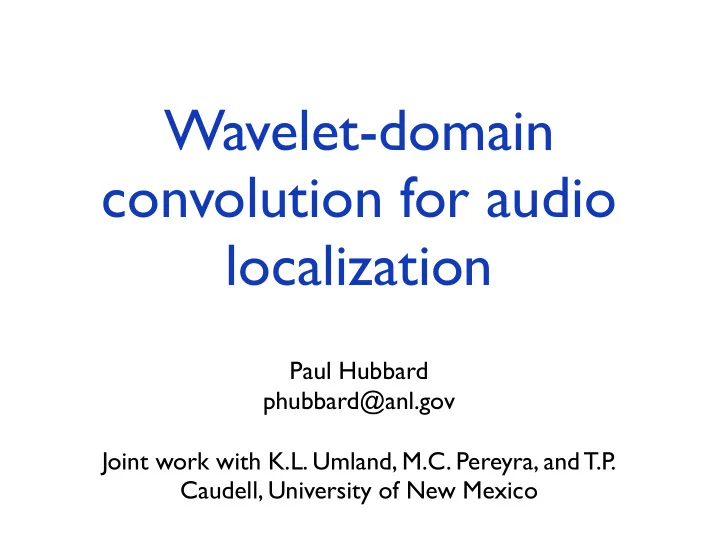

Wavelet-domain convolution for audio localization Paul Hubbard phubbard@anl.gov Joint work with K.L. Umland, M.C. Pereyra, and T.P . Caudell, University of New Mexico
Overview of talk • Background • Introduction to audio localization • HRTFs: what and why • Motivation • Non-standard form • Wavelet-domain convolution • Results and discussion
Background • How can you tell where a sound is coming from with your eyes closed? • Inter-aural time difference and the all- important pinnae • HRTF: Head Related Transfer Function • Anything convolved with an HRTF will appear to originate where the HRTF was measured. This is audio localization.
Localization procedure • Load (monaural) source audio • Choose an HRTF based on 3D location relative to the listener • Azimuth and elevation; distance via attenuation • Convolve the source twice; once with the HRTF for each ear • Example: Piano, 40 degrees right and level
Localization Notes • Localization is resource intensive • Array of HRTFs - hemisphere, sampled every 5 degrees • Computation to perform convolution • Sensitive to time delays • 100msec video-audio error budget • HRTFs vary from person to person • Results best heard via headphones (crosstalk)
Operators and Matrices • We can write each HRTF as a circulant matrix, and ‘filter’ by multiplying the matrix by the input audio clip • Usually not done this way because matrix-vector multiplication is less efficient than simple convolution • Have to deal with circulant wraparound
Why Wavelet-Domain Convolution? • Existing (Miner) sound synthesis system that operates in the wavelet domain • What if we could generate and localize in the wavelet domain? • Avoid extra transformations; this implies less latency and reduced CPU overhead • Q: What does convolution as an operator look like in the wavelet domain?
Proposed method Array of wavelet-domain source sounds Sound Sound model Selector (based on event) modifications Sound Sound Array of wavelet-domain HRTFs HRTF (theta, phi) f(t) Selector Wavelet domain Inverse wavelet HRTF (theta, phi) (based on location) convolution transform HRTF (theta, phi) Figure 1: Flowchart of proposed method
Non-Standard Matrices • Beylkin et al derived a method for approximating an operator matrix to an arbitrary degree of accuracy in the wavelet domain, and a fast matrix- vector multiplication to apply it • If the operator compresses well, potentially more efficient than the FFT. However, matrix area quadruples. • This presentation is an application of their results. • See Beylkin’s papers for more details • (Wavelets, Multiresolution Analysis, and Fast Numerical Algorithms: A draft on INRIA lectures, G. Beylkin)
Non-Standard Form, continued • We are attempting to compress the HRTFs via choice of a suitable wavelet basis and error threshold • Beylkin et al predict that compressibility will scale with the number of vanishing moments in the wavelet basis. • Best case: Matrix-vector multiplication requiring O(N) computations
Test setup • For a chosen audio clip, compare exact convolution with lossy wavelet-domain convolution using different basis functions and error thresholds • Daubechies 4, 20, Coiflet 5, & Beylkin bases • Not tested: Detail level parameter (discard all scales below parameter k) • Simple subjective evaluations of results
Results and Evaluation Wavelet Epsilon Percent NZ Megaflops Evaluation Daubechies-4 0.0001 9.80 868.5 Excellent Daubechies-4 0.0002 8.33 744.1 Passable Daubechies-4 0.0004 6.05 551.4 Poor Daub.-20 0.0001 7.83 842.2 Excellent Daub.-20 0.0002 5.79 669.7 Passable Daub.-20 0.0004 4.02 520.0 Poor Coiflet-5 0.0001 7.76 928.7 Excellent Coiflet-5 0.0002 5.72 756.5 Passable Coiflet-5 0.0004 4.04 614.1 Poor Beylkin 0.0001 7.23 765.0 Excellent Beylkin 0.0002 5.33 607.1 Passable Beylkin 0.0004 4.34 528.6 Good
A quick demonstration • Source clip • Localized via time domain convolution (MATLAB’s ‘convolve’ function) • Done via wavelet-domain convolution: • Daubechies-20, epsilon at 0.0001 • Daubechies-20, epsilon at 0.0002 • Daubechies-20, epsilon at 0.0004 • Beylkin, epsilon at 0.0004 • Note: All used the same (0,40,’R’) HRTF
By Way of Comparison • Reference time-domain convolution required 52.9 megaflops • Our best result is 520 megaflops, and that with lesser audio fidelity • Reference convolution also required a lot less memory • 4096x4096 matrix, 10^5 entries • Did not observe much variation in compression as correlated with the number of vanishing moments
Why is it so inefficient? • These filters (HRTFs) exhibit extremely poor compression; this causes the number of non-zero matrix entries to rise rapidly • Furthermore, the artifacts of this compression are readily audible even at moderate error thresholds • Lack of an analytic HRTF hampers our understanding
Other Possible Approaches • Psycho-acoustic masking • Also known as (MP3, AAC, Ogg Vorbis, etc) encoding • 10:1 compression is routine, with excellent results • Uses knowledge of auditory perception to decide, instead of coefficient magnitudes • Best basis search to find a basis that has better compression behavior
Closing Remarks • http://www.phfactor.net/wdconv for code, audio clips, etc • WD-convolution might be useful for filters with better compressibility
Recommend
More recommend